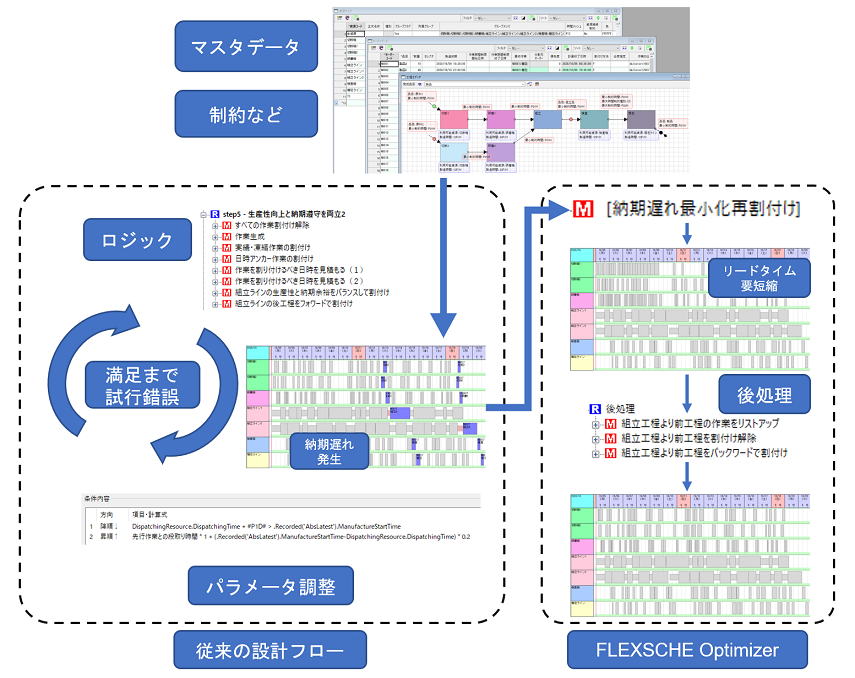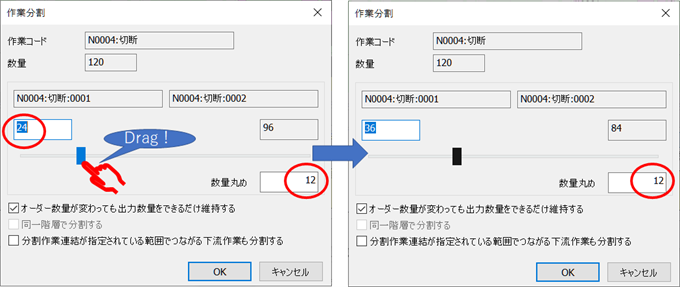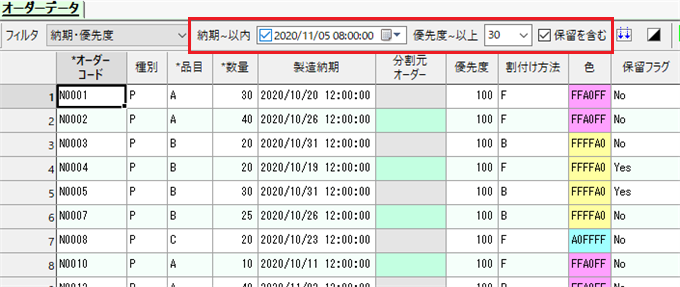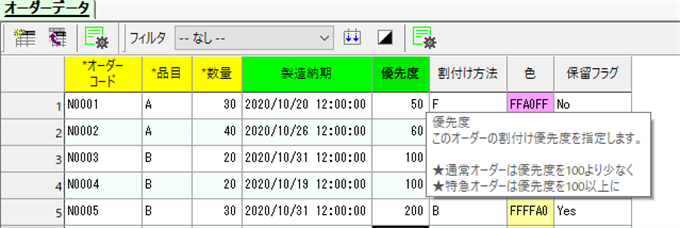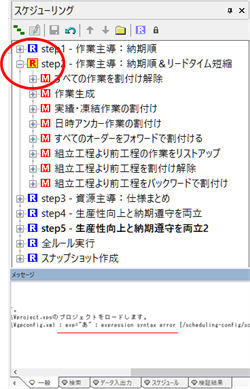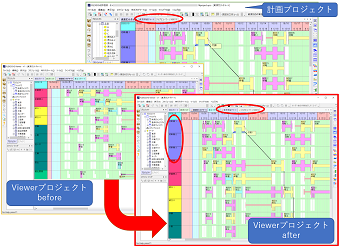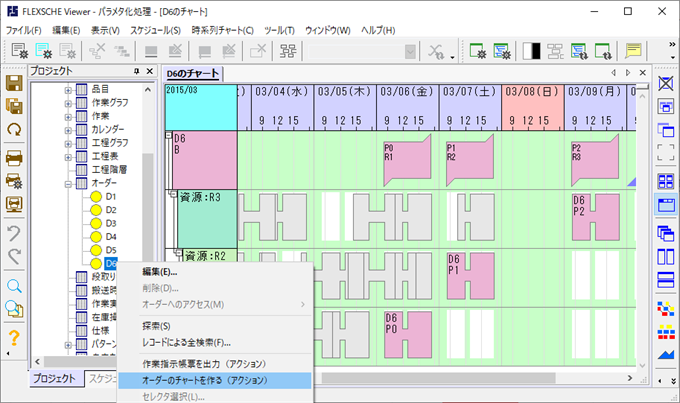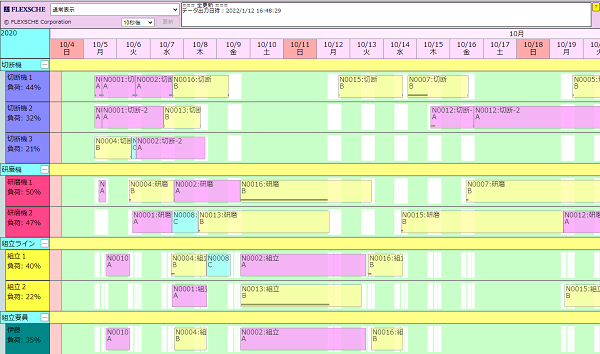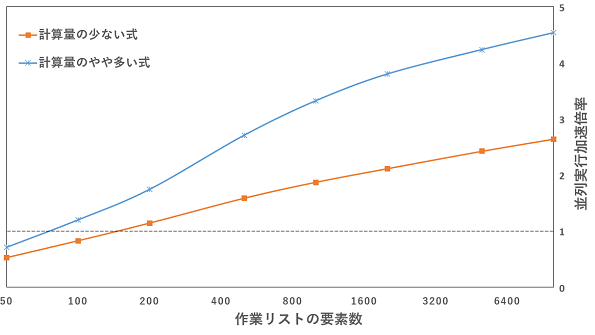FLEXSCHE Version 21
FLEXSCHE version 21.0 was released on February 15, 2022. Numerous feature enhancements have been made. Here are some of the main ones. (Differences between version 20.0 and version 21.0)
FLEXSCHE Optimizer
Facilitate the Development of Complex "Scheduling Logic"
Adjusting scheduling rules meticulously requires advanced technical skills. Especially when factors such as switching and batch furnace lot combinations, which greatly influence the adherence rate to delivery dates, appear, simply arranging operations in "delivery order" will not yield satisfactory planning results. To achieve sufficient results, meticulous adjustment of scheduling rules is necessary. Building such scheduling rules is akin to algorithm development, requiring high training costs, and training engineers capable of handling it is also challenging.
"FLEXSCHE Optimizer" is a product line to break the current situation, and the "Minimize Overdue Method" released with version 21 is the first step.
Dynamic Changeover × Strict Deadlines
Consider a case where there is a dynamic changeover constraint, where preparation time changes depending on the order of operations, and strict deadlines are imposed. If you respond with existing functions, you can consider using the "Resource-driven Dispatching Method" to control the order of operations on resources by considering both changeover time and deadlines. However, to achieve this, it is also necessary to extract bottlenecks, identify the target processes for order control, and analyze the distribution of operation time and dynamic changeover time while complying with inter-process constraints, tuning multiple parameters simultaneously. All of these require a lot of trial and error, leading to increased costs and risks of implementation. (See "Traditional Design Flow" in the diagram below)
In contrast, the "Minimize Overdue Method" targets assigned operations and automatically searches for a configuration with less overdue than the pre-method execution state, using mathematical optimization techniques from all configurations that satisfy constraints (including upstream and downstream). Even starting from the default rule's plan results, which simply arrange by due date, you can achieve a plan with no overdue or improved due date compliance. If a better initial plan is provided, it is also expected to achieve optimal plan results in a shorter time.
How to Set Up the "Minimize Overdue Method"
Specify the target operations and set the [Number of Threads Used] and [Solver Maximum Usage Time] according to the specs of the PC to be executed, then just wait for the optimal results.
Scheduling/Modeling
Enhancement of Feedback from Results to Planning
To further reduce the gap between planning and actual results, we have enhanced the feedback function from operation results.
Result Defective Quantity
In the operation result record, you can now specify not only the actual values of input and output quantities but also the actual values of defective quantities.
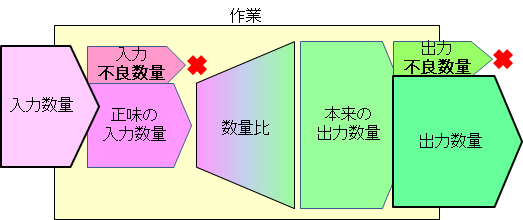
When you specify defective quantities for consumption items, the quantity reduced by that amount is considered the net quantity used in actual manufacturing.
Additionally, by accumulating the actual quantities and actual defective quantities of output items, it can be utilized to calculate the actual yield rate.
Enhancement of Result Quantity Propagation
We have enhanced the "Propagate Result Quantity" function, which updates the input and output quantities of downstream operations based on the result quantities.
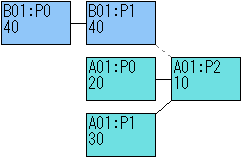 Before Propagation
Before Propagation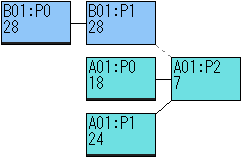 After Propagation
After PropagationWe have particularly strengthened the following points:
- It is now possible to propagate even if only part of the split operations is completed.
- When the quantity decreases, the split operations at the propagation destination are automatically deleted according to the quantity.
- It now supports result defective quantities.
- The "Assign Result/Frozen Operations Method" can now be executed independently.
Part-Specific Search Start Time
The search start time of the Operation-driven Dispatching Method can now be specified separately for each part: setup, manufacturing, and teardown.
This is convenient when you want to control the assignment time of each part individually.
Quantity Rounding Specification During Manual Split
It is now possible to "round quantities" when determining quantities during manual splits.
When determining the split quantity with a slider bar, it was previously moved by a quantity of 1, but now you can adjust the quantity by a multiple of any integer specified in the rounding field.
It becomes easier to specify in units of any lot size, such as dozens.
Improved Memory Usage Efficiency for Large Data
When handling large amounts of data, such as when there are many operations to be planned, FLEXSCHE uses a lot of memory to execute scheduling quickly.
With this improvement, when using the same key for comments or flags in records, sharing the key can reduce memory usage and improve memory usage efficiency.
Actual Data:
Previous Version 6.46GB Version 21 5.62GB Reduced memory usage by approximately 13%
User Interface
Editor Table
Ease of Input for Filter and Sort Parameters
It is now possible to input filter and sort parameters in the editor table using input fields that match the type of parameter.
For example, for date-time type parameters, previously, you had to enter all the date-time in a text box, but now you can use a date-time input field, making it clearer and easier to input. For boolean types, you can simply click a checkbox without entering text.
Ability to Change Column Header Colors and Descriptions
It is now possible to change the header colors and descriptions of columns that are added by default and not user-defined.
This makes it easier to perform master maintenance, such as grouping input items by header color or adding notes to default descriptions.
Scheduling Panel
Visualize Rules with Errors from the Panel
Scheduling rules that are in an error state due to inconsistencies in formulas, etc., have traditionally been reported in the message panel during loading.
However, since it is easy to overlook if you do not pay attention to the message panel, in version 21, in addition to that, the rule icons on the scheduling panel are also emphasized.
The color of the icon changes for rules in an error state.
FLEXSCHE Communicator
Freely Share Files Other Than XML

In Communicator, previously, only arbitrary XML files in the project folder could be shared. In version 21, files other than XML and files in subfolders can also be shared.
In the Communicator panel, shared files are represented along with the folder hierarchy.
FLEXSCHE d-MPS
Display Legend of Drawing Elements in MPS Editor
It is now possible to display a legend on the graph screen of the MPS editor.
The graph includes multiple bar and line graphs, and it is easy to forget the meaning of each element. In such cases, you can immediately check on the GUI without opening the manual.
FLEXSCHE Viewer
Refer to Planning Charts in Viewer Projects
When exporting data for Viewer, chart information can also be output, and on the Viewer side, views can be formed based on chart information when loading data.
This makes it easy to display the same charts on the Viewer side as those seen in the planning project.
When the chart settings are changed on the planning side, the Viewer side automatically follows suit.
Execute Actions in Viewer
It is now possible to execute actions such as creating or updating charts in the Viewer.
You can dynamically generate charts related to specific orders from the menu or change the configuration of charts according to user input without customization.
FLEXSCHE WebViewer
Style Customization
It is now possible to customize the style of charts.
You can change the appearance to your liking, such as background color, line thickness, and font size.
Expanded Range of Time Axis
The time axis of the chart can now be expanded more than before.
When expanded, scales are displayed in increments of one minute, making it easier to see even short-duration operations.
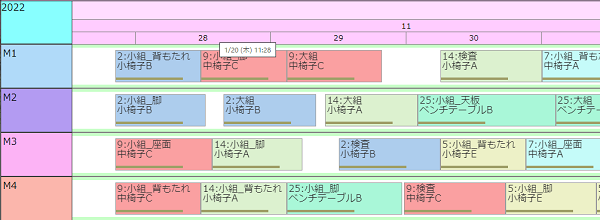
Expression
Expansion of Parallel Execution of Formulas
<List>.Selectand言った計算上の独立性の良い関数は並列実行andの相性is良く、Version 20launch一部to並列化に対応していましたis、New Versionでは更に拡張し、<List>.Select/Sort/Max/Minand moreに対応しました。また、呼び出したExpressionごandに、並列実行するかどうかも制御できるようになりました。
The more elements in the list or the greater the calculation amount of the formula, the more noticeable the acceleration by parallel processing, and in some cases, it accelerates more than five times.
* The experiment was conducted on an 8-core CPU.
List of Added Functions
The number of functions available in expressions has increased, further expanding what you can do.
Other
Enhanced Response to Failures
When a failure occurs during scheduling due to deficiencies in data or scheduling rule settings, a memory dump is now automatically output.
By submitting this file, it becomes possible to analyze the situation during a failure, increasing the likelihood of resolving the issue.

